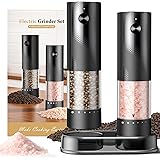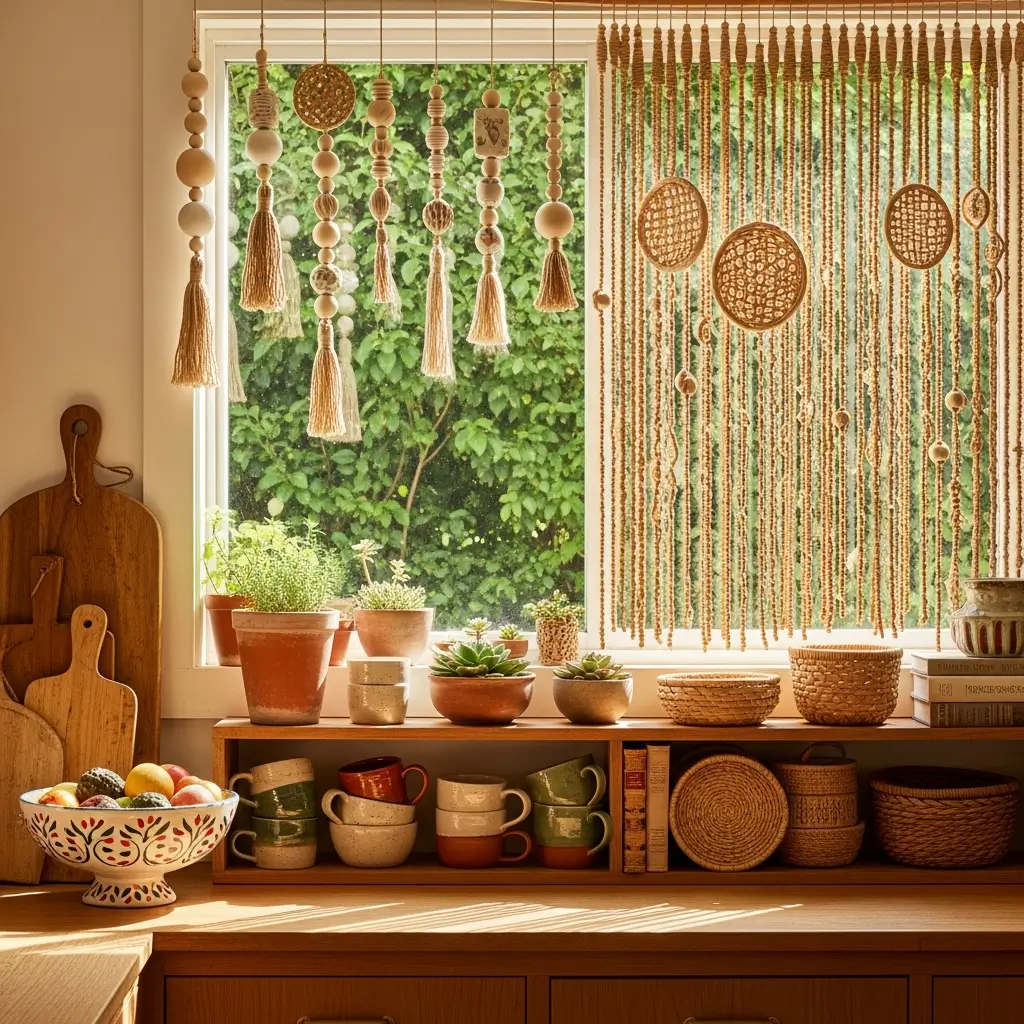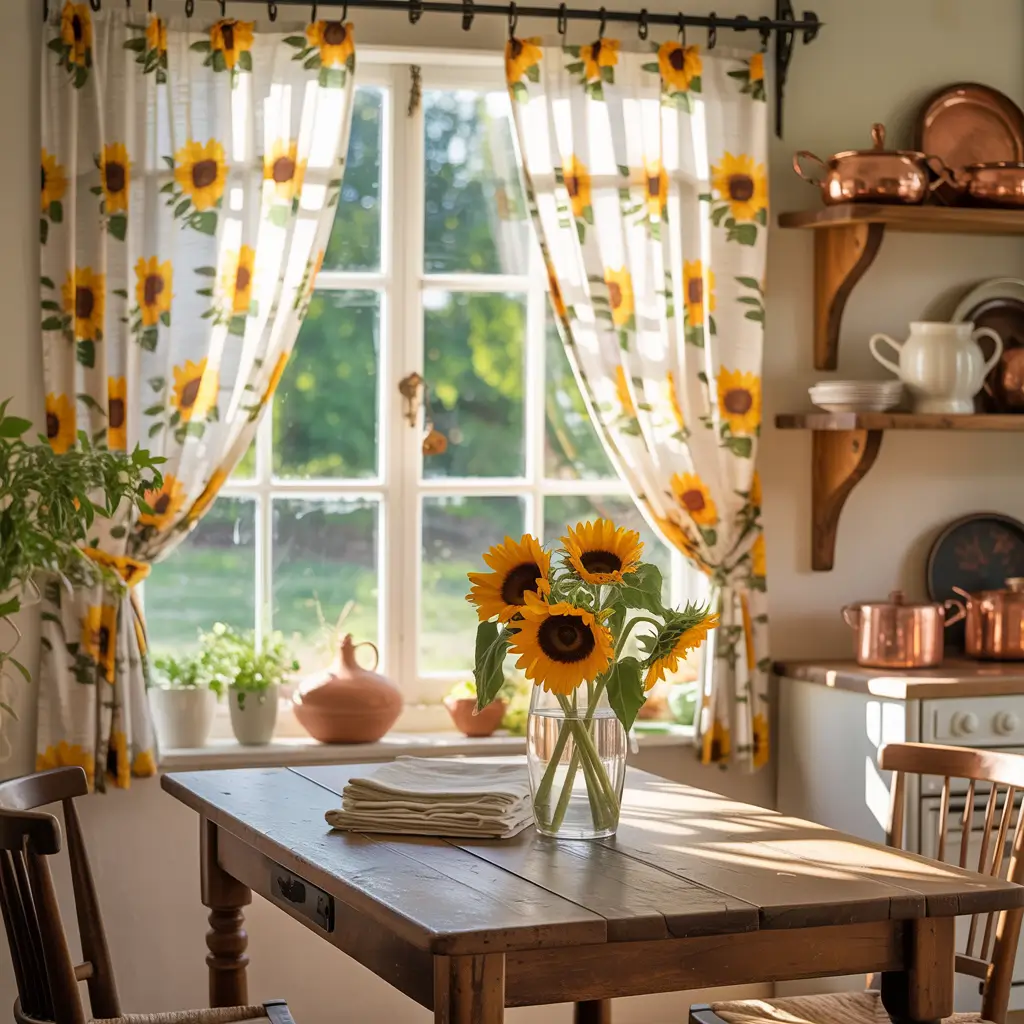15 Stunning Modern Japanese Bedroom Ideas and Zen Decor Tips
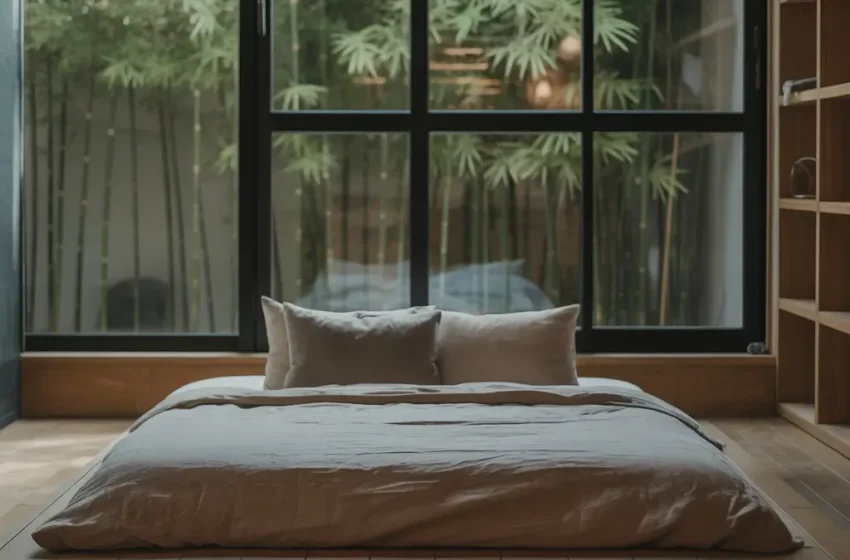
Ukeetap 10" Pro Chicken Shredder Tool Twist Large for Kitchen, BPA-Free Food-Safe Meat Grinder, Visible Chicken Breast Meat Shredder with Strong Anti-Slip Bottom & Ergonomic Handle, Black
$9.99 (as of November 11, 2025 14:34 GMT +00:00 - More infoProduct prices and availability are accurate as of the date/time indicated and are subject to change. Any price and availability information displayed on [relevant Amazon Site(s), as applicable] at the time of purchase will apply to the purchase of this product.)Electric Salt and Pepper Grinder Set - Rechargeable Automatic Salt and Pepper Shakers, Kitchen Appliances with External Adjustable Coarseness, Larger Hopper for Cooking, Home Gifts(2 Pack,Black/Black)
$23.99 (as of November 11, 2025 14:34 GMT +00:00 - More infoProduct prices and availability are accurate as of the date/time indicated and are subject to change. Any price and availability information displayed on [relevant Amazon Site(s), as applicable] at the time of purchase will apply to the purchase of this product.)BNBUN Bamboo Cutting Board for Kitchen, Wooden Cutting Board 3-Piece Set with Non-Slip Mat Deep Juice Groove and Built-In Handles, Wood Cutting Board for Meat Vegetables Fruit Ideal Gift for the Home
$29.99 (as of November 11, 2025 14:34 GMT +00:00 - More infoProduct prices and availability are accurate as of the date/time indicated and are subject to change. Any price and availability information displayed on [relevant Amazon Site(s), as applicable] at the time of purchase will apply to the purchase of this product.)Bidobibo Bear Straw Cup, Cute Baby Straw Cups Glass, Honey Bear Cup with Straws, Cute Mugs for Coffee Drinks 20oz (1 PC)
$29.99 (as of November 11, 2025 14:34 GMT +00:00 - More infoProduct prices and availability are accurate as of the date/time indicated and are subject to change. Any price and availability information displayed on [relevant Amazon Site(s), as applicable] at the time of purchase will apply to the purchase of this product.)Food Vacuum Sealer Machine, 75KPA Strong Suction, Dry/Wet Modes, 20 Vacuum Seal Bags for Food, Digital Countdown Timer, Compact Lightweight, Ideal for Home Kitchen Use
$24.99 (as of November 11, 2025 14:34 GMT +00:00 - More infoProduct prices and availability are accurate as of the date/time indicated and are subject to change. Any price and availability information displayed on [relevant Amazon Site(s), as applicable] at the time of purchase will apply to the purchase of this product.)8 Blade All-in-1 Vegetable Chopper Mandoline Slicer with Container, Food Chopper, Onion Chopper, Veggie Cutter for Salad, Kitchen Gadgets Accessories Essentials, White
$29.99 (as of November 11, 2025 14:34 GMT +00:00 - More infoProduct prices and availability are accurate as of the date/time indicated and are subject to change. Any price and availability information displayed on [relevant Amazon Site(s), as applicable] at the time of purchase will apply to the purchase of this product.)FUMMDUS Meat Thermometer Digital, 3S Instant Read Food Thermometer for Cooking with Backlight & Magnet, Foldable Temperature Probe Kitchen Gadgets Essentials for Turkey BBQ Grill Smoker Candy
$9.99 (as of November 11, 2025 14:34 GMT +00:00 - More infoProduct prices and availability are accurate as of the date/time indicated and are subject to change. Any price and availability information displayed on [relevant Amazon Site(s), as applicable] at the time of purchase will apply to the purchase of this product.)Amazon Basics Organic Cotton Waffle Kitchen Dish Towels - Ultra Absorbent, Quick Drying, Lint-Free, 15 x 25 inches, 6-Pack (4 Navy Strip/Checker, 1 White, 1 Solid Navy)
$15.19 (as of November 11, 2025 14:34 GMT +00:00 - More infoProduct prices and availability are accurate as of the date/time indicated and are subject to change. Any price and availability information displayed on [relevant Amazon Site(s), as applicable] at the time of purchase will apply to the purchase of this product.)Warming Mat for Food Extra Large 32"x15", Electric Silicone Food Warmer Trays for Chafing Dishes & Buffet,Portable Countertop Food Warmers for Parties, 7-Level Temp 8-Hour Timer, Blue
$49.99 (as of November 11, 2025 14:34 GMT +00:00 - More infoProduct prices and availability are accurate as of the date/time indicated and are subject to change. Any price and availability information displayed on [relevant Amazon Site(s), as applicable] at the time of purchase will apply to the purchase of this product.)F-Caw-F Funny Chicken Humor F-Caw-F Quote Rooster Meme Stainless Steel Insulated Tumbler
$18.69 (as of November 11, 2025 14:34 GMT +00:00 - More infoProduct prices and availability are accurate as of the date/time indicated and are subject to change. Any price and availability information displayed on [relevant Amazon Site(s), as applicable] at the time of purchase will apply to the purchase of this product.)You know that feeling when you walk into a space and instantly feel your shoulders drop? That’s exactly what happened to me the first time I stepped into a proper Japanese-style bedroom. No clutter, no chaos – just pure, peaceful vibes that made me want to curl up with a good book and forget the world existed.
If you’re anything like me, you’ve probably scrolled through countless bedroom inspiration posts, wondering how to capture that effortless Japanese aesthetic without making your room look like you raided a Tokyo gift shop. Well, good news – I’ve spent way too much time obsessing over this stuff, and I’m here to share 15 modern Japanese bedroom ideas that actually work in real homes. Not just Instagram-perfect spaces that nobody actually lives in.
Minimalist Zen Bedroom with Tatami Mats
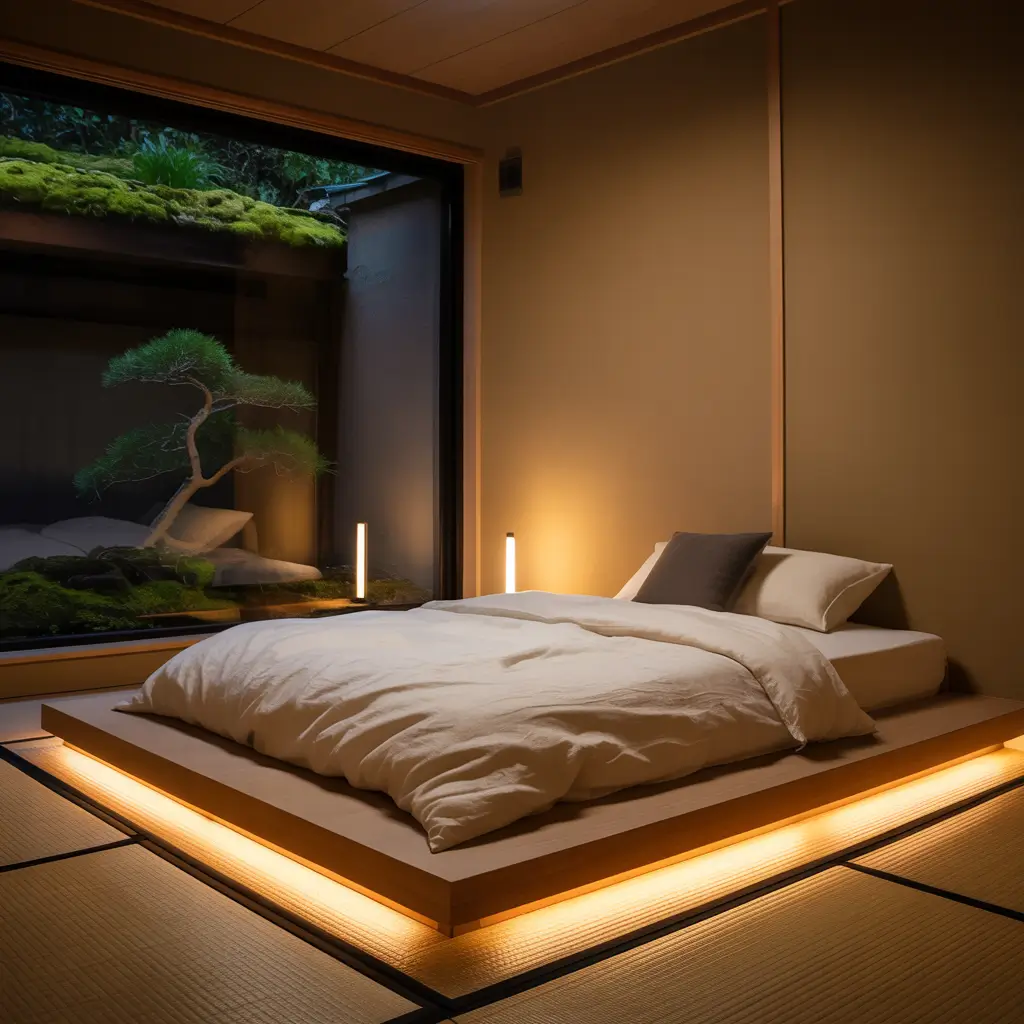
Let’s kick things off with the classic – tatami mats. These aren’t just floor coverings; they’re basically the foundation of Japanese bedroom design. I remember thinking tatami would be scratchy and uncomfortable, but wow, was I wrong. They smell like fresh grass (seriously, it’s amazing), and they give your room this instant zen quality that carpeting just can’t match.
The best part? You don’t need to cover your entire floor. Just creating a designated sleeping area with tatami instantly transforms the space. Place your futon or low bed directly on them, and boom – you’ve got yourself a legitimate Japanese sleeping zone.
Getting the Look Right
Here’s what works:
- Natural tatami mats (the real ones, not the plastic imposters)
- Keep furniture minimal – think one low table, maybe a floor cushion
- Stick to neutral colors: beige, cream, soft greens
- Add one piece of simple artwork – nothing busy
The trick is restraint. Every time you want to add something, ask yourself: does this spark joy, or am I just filling space? Nine times out of ten, less really is more here.
Neutral Toned Japanese Futon Layout

Okay, can we talk about futons for a second? Not those college dorm futons that basically destroyed your back – I’m talking about proper Japanese futons. These babies are game-changers. They’re firm enough to support your spine but soft enough that you don’t feel like you’re sleeping on concrete.
The beauty of a futon setup is the flexibility. Roll it up during the day, and suddenly your bedroom doubles as a yoga studio, office, or whatever you need. Plus, sleeping closer to the ground has this grounding effect that I can’t quite explain – you just have to try it.
Making It Work in Western Homes
- Choose high-quality cotton or wool futons (synthetic ones get gross fast)
- Invest in a proper futon cover in linen or cotton
- Consider a tatami platform if you’re not ready for floor sleeping
- Keep bedding simple: white, beige, or soft gray
Low-Profile Platform Bed with Shoji Screens

Not ready to commit to floor sleeping? I get it. A low-profile platform bed gives you that Japanese aesthetic while keeping you off the ground. Pair it with shoji screens, and you’ve created zones in your bedroom without building actual walls.
I installed shoji screens in my bedroom last year, and honestly? Best decision ever. They filter light beautifully in the morning (goodbye, harsh wake-ups), and they make the space feel larger somehow. Physics? Magic? Who knows, but it works.
Shoji Screen Placement Tips
The placement matters more than you’d think:
- Use them to hide storage areas or create a dressing corner
- Position screens near windows for diffused natural light
- Consider sliding screens if you’re tight on space
- Don’t overdo it – one or two screens max
Also Read: 15 Stunning Master Bedroom Modern Ideas to Transform Your Space
Japanese-Inspired Bedroom with Natural Wood Accents

Wood is basically the MVP of Japanese design. But here’s the thing – we’re not talking about that orange-y oak from the 90s. Think light woods like pine, bamboo, or ash. The grain should be visible but not overwhelming.
My bedroom has this simple pine platform bed frame I built myself (YouTube University, FYI), and it completely changed the room’s energy. The natural wood brings warmth without heaviness, if that makes sense.
Wood Elements That Work
- Exposed wooden beams (if you’re lucky enough to have them)
- Simple wooden bed frames with clean lines
- Bamboo blinds instead of heavy curtains
- A single piece of live-edge furniture as a statement
Compact Modern Japanese Bedroom for Small Spaces
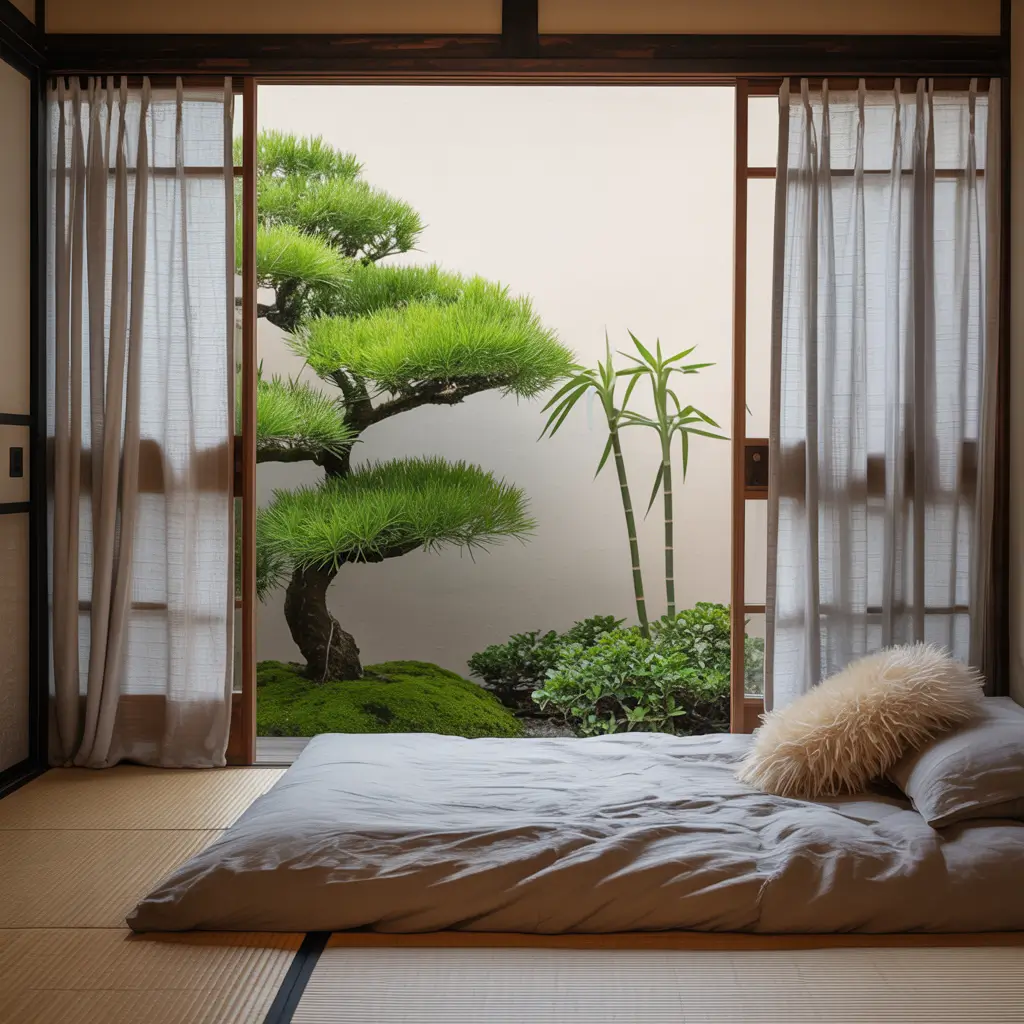
Living in a shoebox apartment? Join the club! Japanese design is literally perfect for small spaces because it’s all about multi-functional everything. Your nightstand becomes storage, your bed has drawers underneath, and suddenly your tiny room feels twice as big.
The key is choosing furniture that serves multiple purposes without looking cluttered. Think ottoman storage boxes that double as seating, or a low table that works for both tea and laptop time.
Space-Saving Tricks
Here’s what actually works in small spaces:
- Wall-mounted lighting instead of table lamps
- Under-bed storage boxes in natural materials
- Foldable furniture that can disappear when not needed
- Vertical storage using wall-mounted shelves
Serene Japanese Bedroom with Indoor Plants
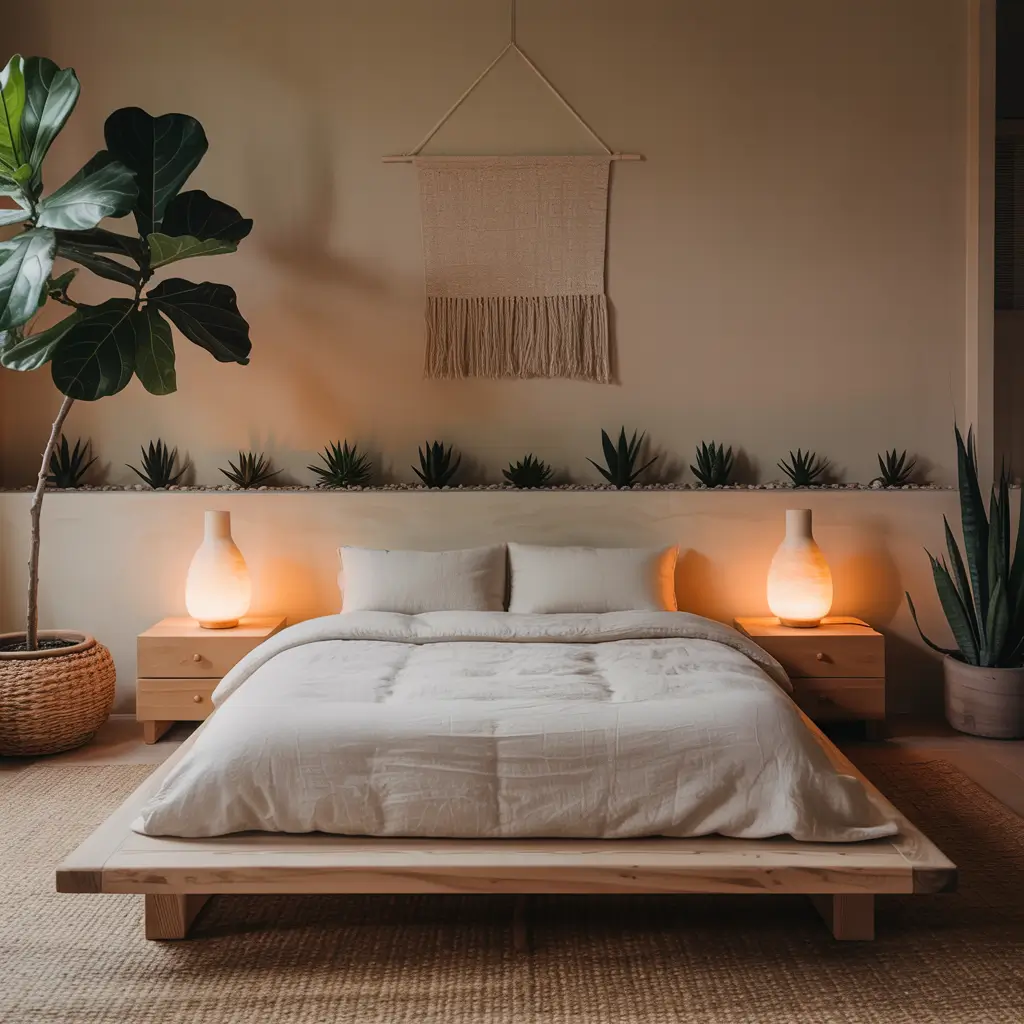
Plants and Japanese design go together like coffee and mornings. But we’re not talking about turning your bedroom into a jungle. Choose one or two statement plants that complement the minimal aesthetic.
My personal favorites? A single bonsai tree (yes, I’m that person) or a tall bamboo plant in the corner. They add life without chaos, and taking care of them becomes part of your morning ritual. There’s something meditative about watering your plants while the coffee brews.
Best Plants for Japanese Bedrooms
- Bonsai trees (if you’re committed to the care)
- Lucky bamboo (basically indestructible)
- Peace lilies (they even clean your air)
- A simple snake plant for zero-maintenance greenery
Also Read: 15 Stunning 3 Bedroom House Plans Modern Ideas for Stylish
Black and White Modern Japanese Bedroom

Who says Japanese design has to be all beige and brown? A monochrome palette can look incredibly striking while maintaining that zen feel. The trick is balancing the contrast – too much black and your bedroom becomes a cave; too much white and it feels like a hospital.
I’ve seen this done brilliantly with black wooden furniture against white walls, with just touches of gray in the bedding. It’s modern, sophisticated, and still totally peaceful.
Nailing the Monochrome Look
Keep these ratios in mind:
- 70% white (walls, major furniture)
- 20% black (bed frame, artwork frames)
- 10% gray (bedding, cushions, throws)
- Add texture to prevent flatness
Contemporary Japanese Bedroom with Sliding Doors

Sliding doors aren’t just space-savers; they’re design statements. Whether you go for traditional shoji-style or modern glass panels, they instantly elevate your bedroom from basic to boutique hotel vibes.
My closet has sliding barn doors now (okay, not traditionally Japanese, but same concept), and I’ll never go back to regular doors. They save so much space and look incredibly sleek. Plus, there’s something satisfying about that smooth sliding motion – way better than creaky hinges at 2 AM.
Types of Sliding Doors to Consider
- Traditional shoji screens for authentic vibes
- Frosted glass panels for modern aesthetics
- Wooden slat doors for privacy with airflow
- Mirror sliding doors to expand visual space
Cozy Japanese Bedroom with Warm Lighting
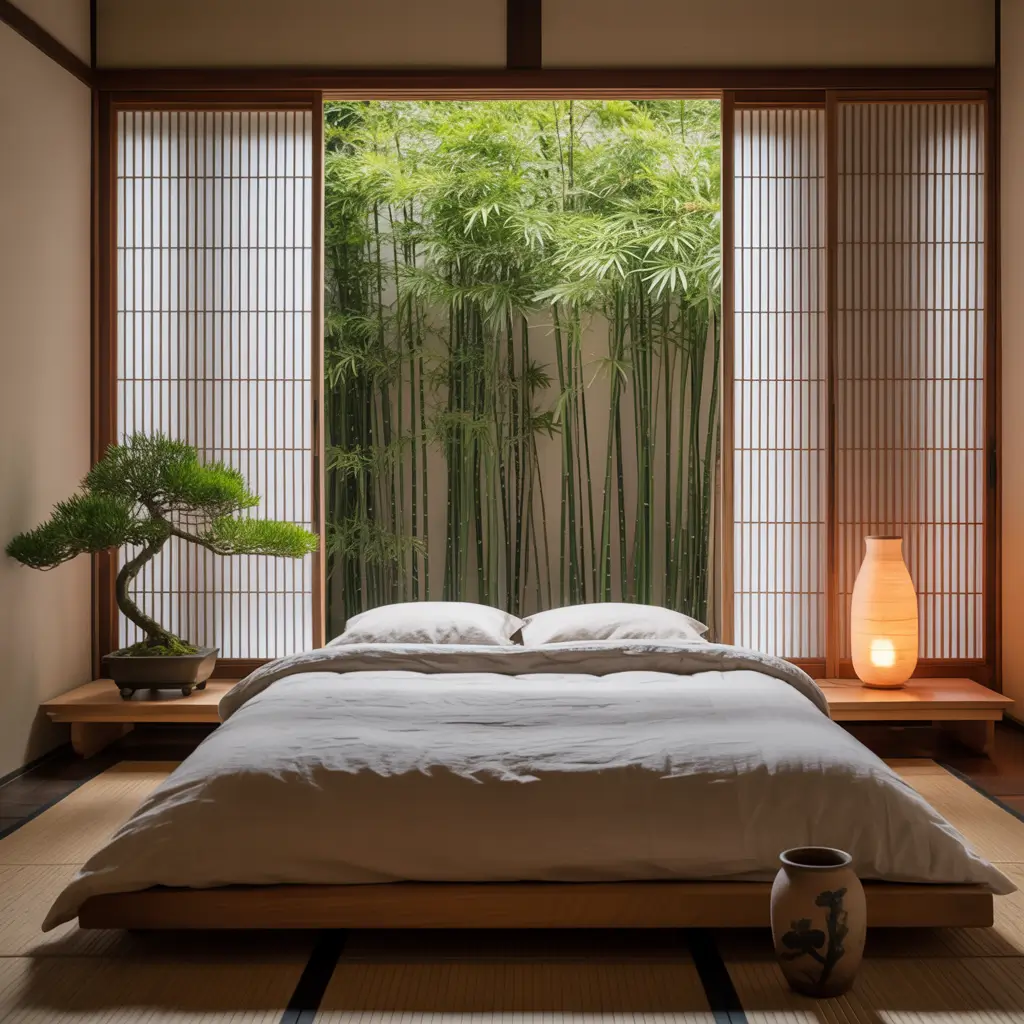
Lighting can make or break your Japanese bedroom. Forget those harsh overhead lights – we’re going for warm, diffused glows that make you want to hibernate. Paper lanterns are the classic choice, but modern rice paper pendants work just as well.
I swear by multiple light sources at different heights. A low floor lamp here, some LED strips behind the headboard there – it creates layers of light that you can adjust based on your mood. Way better than that one sad ceiling fixture, right?
Lighting Ideas That Set the Mood
- Paper lanterns at varying heights
- Hidden LED strips for ambient lighting
- Salt lamps for that warm, orangey glow
- Candles (real or battery-powered) for evening vibes
Also Read: 15 Stunning Modern Cottage Bedroom Ideas for Cozy Spaces
Modern Japanese Loft Bedroom Design

Got high ceilings? Lucky you! A loft bedroom with Japanese influences combines the best of both worlds – vertical space usage and minimal design. The key is keeping the loft area super simple while the space below remains functional.
Think sleeping area up top with just a futon and maybe a small shelf, while below serves as your dressing area or study space. It’s efficiency at its finest, and it looks incredibly cool too.
Making Loft Spaces Work
Here’s how to maximize that vertical real estate:
- Keep the loft area minimal – just sleep essentials
- Use the lower space for storage and daily activities
- Install subtle lighting in both areas
- Add a simple ladder or narrow stairs (nothing chunky)
Japanese Bedroom with Minimalist Storage Solutions
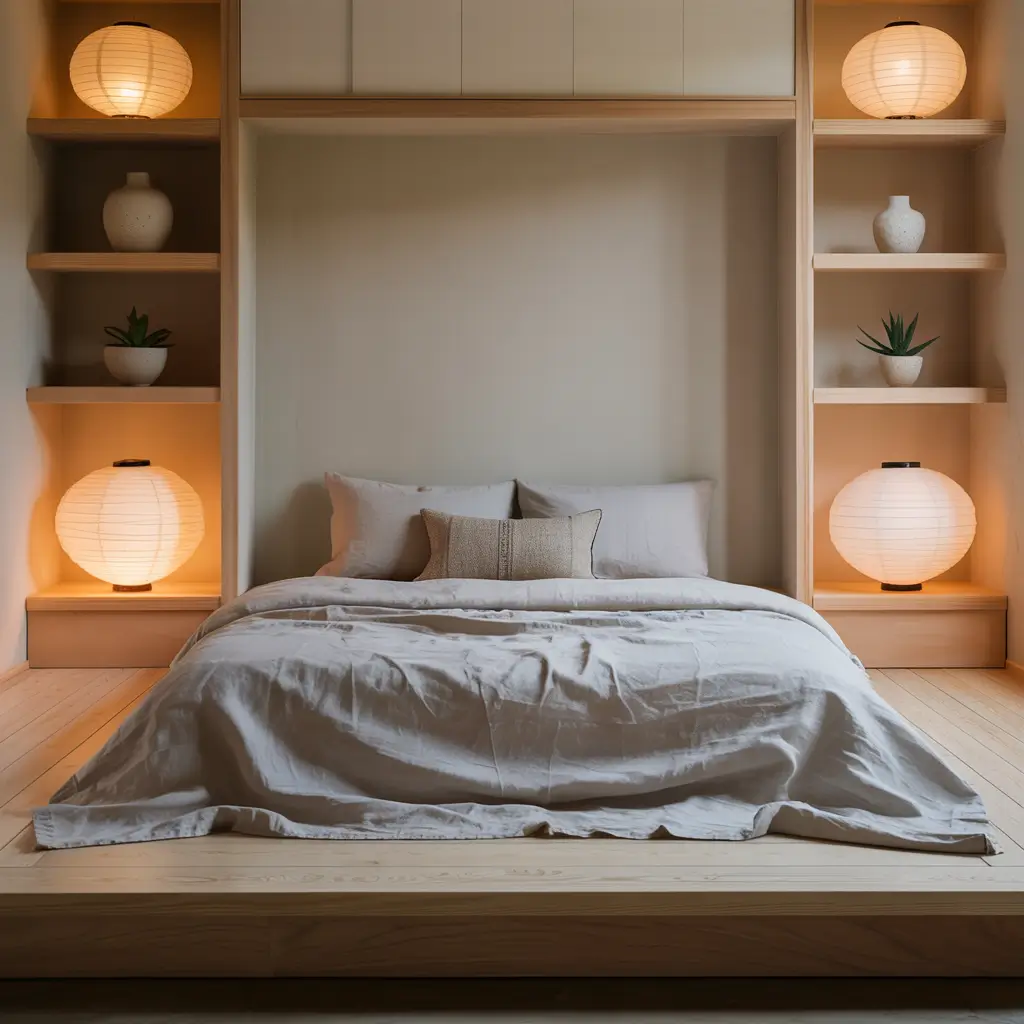
Storage in a Japanese bedroom isn’t about hiding everything away – it’s about intentional organization. Those built-in closets with sliding doors? Pure genius. Everything has its place, and nothing sits out unless it deserves to.
I converted to this system last year, and my morning routine got so much smoother. When everything has a designated spot, you stop wasting time hunting for that one shirt or your favorite socks. It’s like meal prep, but for your closet 🙂
Smart Storage Solutions
- Built-in wardrobes with sliding doors
- Under-bed drawers in natural wood
- Wall-mounted shelves with hidden brackets
- Storage benches at the foot of the bed
Neutral Japanese Bedroom with Paper Lanterns
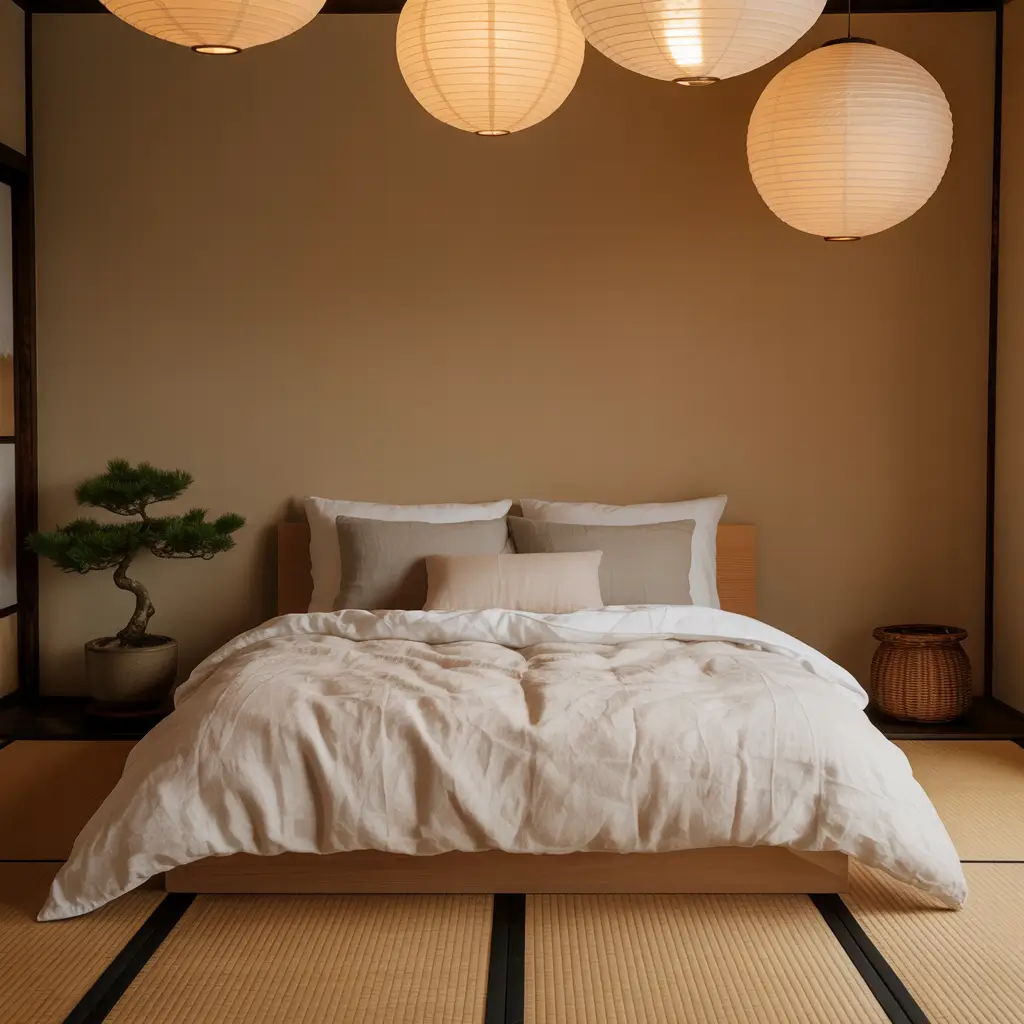
Paper lanterns deserve their own moment because they’re just that good. They transform harsh light into this soft, dreamy glow that makes everyone look better (Instagram filters, who?). Plus, they’re crazy affordable for the impact they make.
Mix different sizes for visual interest – a large statement lantern over the bed, smaller ones in corners. Just remember to use LED bulbs unless you want to explain to your landlord why there’s a scorch mark on the ceiling. Trust me on this one.
Paper Lantern Placement Tips
- Hang the largest lantern as your focal point
- Group smaller lanterns in odd numbers
- Vary the heights for visual interest
- Choose warm white bulbs over cool white
Scandinavian-Japanese Fusion Bedroom

Scandi-Japanese fusion (or “Japandi” if you’re feeling trendy) combines the best of both aesthetics. You get Japanese minimalism with Scandinavian coziness – basically, hygge meets zen. It’s having your cake and eating it too, design-wise.
The color palette stays neutral, but you add more textiles than traditional Japanese design. Think chunky knit throws on your low platform bed, or a sheepskin rug next to your tatami mats. It shouldn’t work, but somehow it totally does.
Achieving the Japandi Balance
Key elements to nail this look:
- Natural materials from both cultures
- Neutral colors with occasional black accents
- Mix smooth and textured surfaces
- Balance minimal furniture with cozy textiles
Modern Japanese Bedroom with Statement Art

Here’s where you can break the rules a little. Traditional Japanese bedrooms might have one piece of calligraphy, but modern interpretations can handle bold, contemporary art. The trick is choosing pieces that complement rather than compete with the space.
I have this massive black and white abstract piece above my bed, and it’s literally the only art in the room. It makes a statement without screaming for attention, which is exactly what you want in a bedroom IMO.
Choosing the Right Art
What works and what doesn’t:
- Large-scale pieces work better than gallery walls
- Stick to minimal color palettes
- Abstract or nature-inspired themes fit best
- Frame everything in simple black or natural wood
Open and Airy Japanese Bedroom with Floor Seating
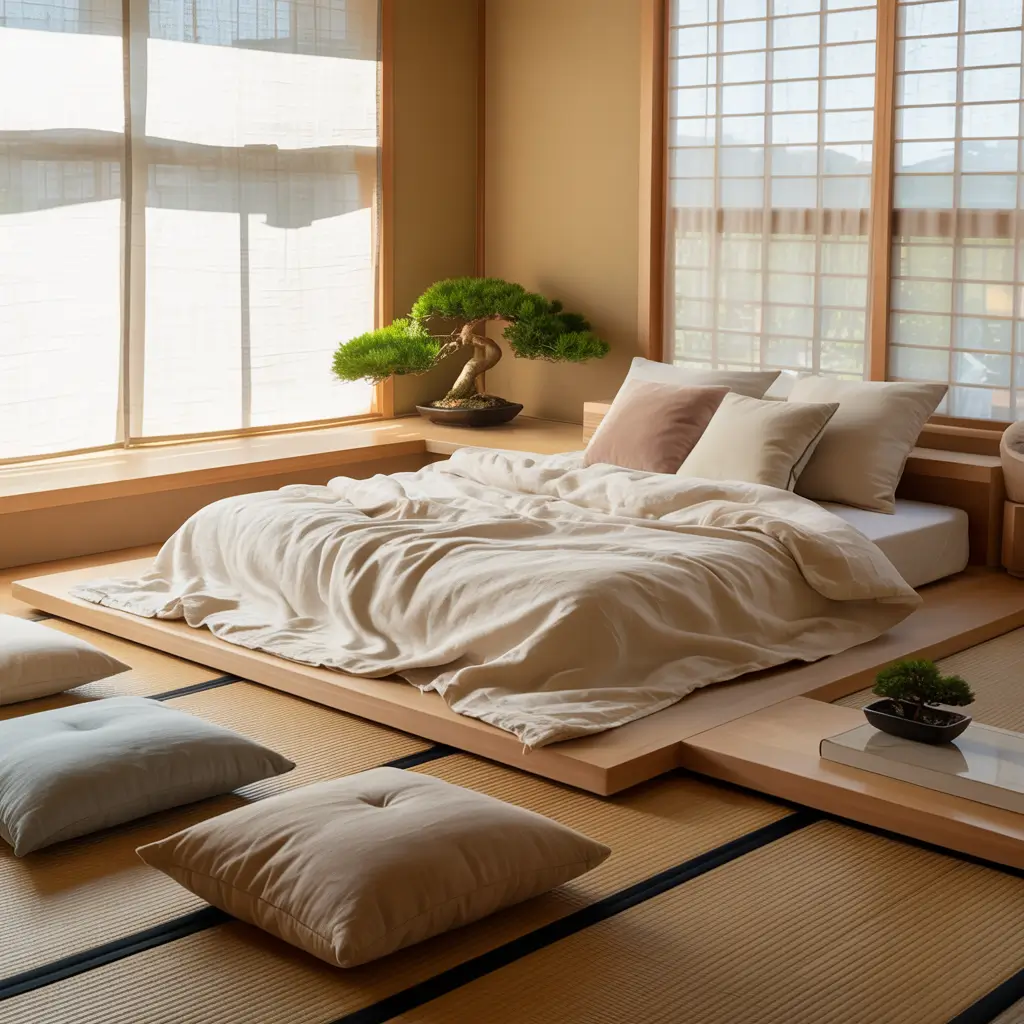
Last but definitely not least – floor seating areas. Creating a little meditation or reading corner with floor cushions instantly makes your bedroom feel more intentional and less like just a place to crash.
I have this corner with a couple of meditation cushions and a low tea table, and it’s become my favorite spot for morning journaling. There’s something about sitting on the floor that makes you slow down and actually be present. Plus, it’s perfect for stretching when you can’t make it to yoga class (which is always, let’s be real).
Creating Your Floor Seating Area
Essential elements for comfort:
- Quality floor cushions (your knees will thank you)
- A low table for tea or books
- Good back support – wall cushions or backrests
- Soft area rug for added comfort
Making It All Work Together
Look, transforming your bedroom doesn’t happen overnight (unless you’re on one of those home makeover shows, and we all know those aren’t real life). Start with one element that speaks to you and build from there. Maybe it’s swapping your bed for a low platform, or perhaps you just add some shoji screens.
The beauty of modern Japanese design is its flexibility. You don’t need to go full traditional to capture the essence. Pick what works for your life, your space, and your budget. The goal is creating a bedroom that feels like a retreat, not a museum.
Remember, the best bedroom is one that makes you excited to go to sleep and happy to wake up. Everything else is just details. Whether you go full tatami mat or just add a paper lantern, the important thing is creating a space that brings you peace. And honestly? In this chaotic world, we could all use a little more of that


